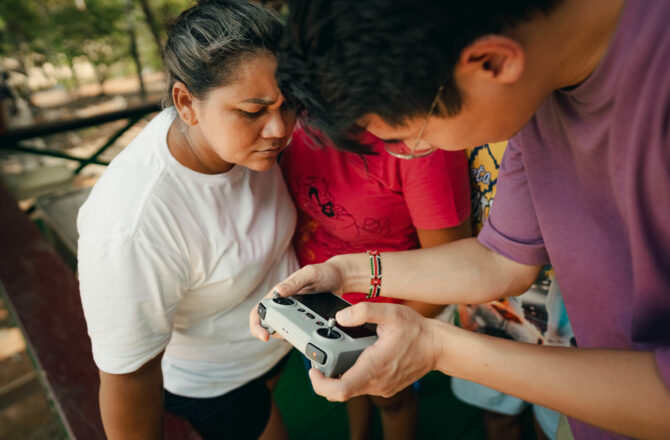
Sofia Costa
The Amazon Rainforest, renowned for its unparalleled biodiversity, is home to countless species, including fungi and other vital organisms. Protecting this ecosystem is critical, and the ETH BiodivX team is at the forefront of this mission. Swissnex in Brazil and Presence Switzerland proudly support the ETH BiodivX team, finalists in the XPRIZE Rainforest competition, as they embark on a groundbreaking project in Brazil.
The ETH BiodivX team, led by ETH Zurich, includes 50 researchers from various disciplines worldwide. It is pioneering technologies that revolutionize how we understand and protect the Amazon. Their work involves developing drones to collect forest data, innovating new DNA sequencing methods, and partnering with local communities and global experts to visualize and interpret this data.
The team gathers extensive eDNA, images, and sounds using autonomous drones and sensors. This data is analyzed with a real-time dashboard through a backpack lab, advanced AI algorithms, and the knowledge of a global community of indigenous citizen scientists.
This is an important moment for the Swiss-led innovation team, as it involves a significant project that addresses nature, biodiversity, innovation, technology, the Amazon, and its ecosystem and promotes academic exchange.
Stefano and members of the ETH BiodivX with their drones preparing for launch.
XPRIZE Rainforest is a global 5-year, $10 million competition that convenes innovators and experts across disciplines – from conservationists and Indigenous scientists to engineers and roboticists – and challenges them to use novel technologies to expedite the monitoring of tropical biodiversity.
Tropical rainforests are the most biodiverse ecosystems on Earth but our ability to fully assess them is restricted as they are so vast and complex. By deploying rapid and autonomous technology into the forest, researchers can gain near real-time insights about biodiversity – providing necessary data that can inform conservation action and policy, support sustainable bioeconomies, and empower Indigenous Peoples and local communities who are the primary protectors and knowledge holders of the planet’s tropical rainforests.
In the competition, the teams competing are faced with a formidable challenge:
The ETH BiodivX team addresses a critical gap in biodiversity knowledge. While many apps allow users to photograph species, their effectiveness is limited by outdated databases. ETH BiodivX aims to enhance these databases and integrate them into more robust applications.
Their drones go beyond traditional remote sensing by collecting physical samples for environmental DNA (eDNA) analysis from various forest levels and water sources. They have also developed a portable lab, enabling rapid sample processing—a key requirement for the XPRIZE Rainforest competition, where speed and efficiency are essential.
The revolutionary eDNA Backpack Lab is a cutting-edge solution for rapid and portable environmental DNA (eDNA) analysis. This compact and versatile laboratory-in-a-backpack will enable scientists, researchers, environmental enthusiasts, as well as local communities to unlock a wealth of information about ecosystems and species presence with unprecedented ease. Anyone will be able to monitor sensitive ecosystems, explore uncharted territories, and contribute to scientific knowledge and conservation efforts in a way that is efficient, convenient, and environmentally conscious.
ETH BiodivX team with DNA samples to analyze and develop meaningful insights.
The ETH BiodivX group introduced an innovative tool, “Taina,” a participatory chatbot designed to empower global citizen science by handling tens of thousands of participants. Integrated within the GainForest dashboard, Taina can seamlessly incorporate into any Discord server and Telegram Bot. Capable of processing thousands of natural observations simultaneously, including images, sounds, and videos, this versatile tool was developed over three months with continual feedback and co-design from local and Indigenous communities around the world, ensuring the chatbot was tailored to meet diverse user requirements.
Taina connects to AI predictions, spreadsheets, and moderation tools, enabling our team of ecologist experts to understand community wisdom for species identification and data analysis. This collaborative approach has given valuable insights, such as the identification of rare species and historical data feedback. The group provides tutorials, dry runs, and a help desk to assist users and ensures that all participants, regardless of their technological proficiency, can effectively engage with our platform.
Transparency and community engagement are essential to their work. The team provides regular updates and sneak peeks via their YouTube channel, making their progress accessible to everyone. The ETH BiodivX also implemented prediction algorithms to identify plants and animals and track insects. This project advances scientific research and provides lasting tools and knowledge for local communities, fostering ongoing collaboration and environmental stewardship.
The ETH BiodivX team aspires to create a sustainable model that rewards local communities for their conservation efforts. The team is dedicated to developing this model, ensuring long-term community involvement in biodiversity monitoring.
Should the team win the competition, the prize will fund a one-year upscale phase. This period will focus on further technological development and establishing a business model to transform their research into a company dedicated to mapping and protecting biodiversity.
David Dao showcasing to the local community how to manage the technology that will be left to them.
Experience the intersection of art, technology, and environmental science at our upcoming event and exhibition on climate change and the Amazon Rainforest. A Swiss-Brazilian transdisciplinary partnership fosters connections and tackles contemporary challenges head-on.
By highlighting the fragmentation of ecosystems due to social neglect, the project emphasizes the contrast between the Amazon’s natural exuberance and the recent droughts and fires. The installation features immersive videos and sounds, showcasing this contrast to expand understanding through documentary video art and environmental DNA decoding. Ultimately, it critically addresses the environmental crisis, emphasizing the pressing water crisis and its immediate challenges.
For more details, visit the Exhibition and Event article.
Sofia Costa
Gabriela Devaud




